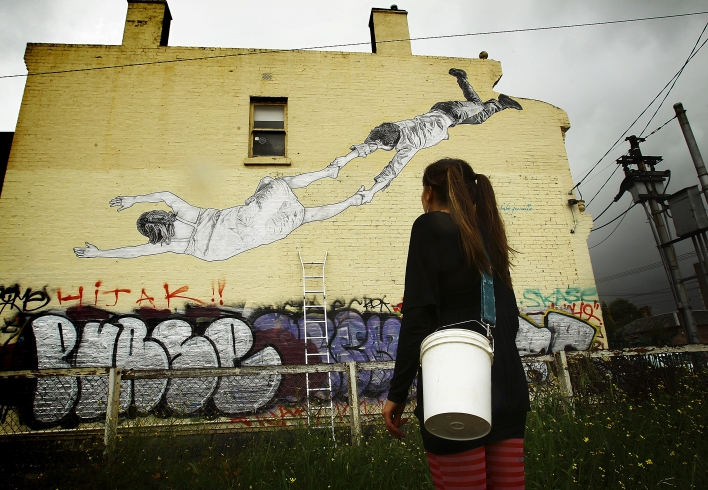Their pseudonyms won’t be found at the NGV, but the likes of Baby Guerrilla, Urbanmonk, and Nomad prefer it that way. ROBERT FEDELE fleetingly inhabits the world of Melbourne’s street artists.
We organise to meet on a Friday morning on Brunswick Road, opposite the train tracks along the Upfield line, scene of perhaps her most noticeable and celebrated of works.
The imposing piece, a 10-metre wide image of a couple clinging to each other in flight, lights up a dreary Melbourne day.
The piece is pasted on to the wall of an otherwise nondescript terrace house. Its creator is less conspicuous, but purely by design. “I want people not to know who I am,” she later reveals.
A few minutes later she arrives decked in a black top and pink tights, a bucket and paintbrush in one hand and a folding ladder snuggled under her arm.
“I wore exactly what I was wearing the day I put it up,” says the Footscray-based artist, who calls herself Baby Guerrilla and is renowned for eclectic paste-ups across Melbourne.
The one we’re here to see went up six months ago.
It began as a detailed ink sketch created in a studio before being cut out and glued to the wall. Other pieces in this series are scattered around Brunswick, Footscray and the CBD.
“I’ve been working on this series of the couple for quite a while. I’m actually doing another one even though I keep thinking it’s going to be the last. I guess it’s a fun subject matter. There’s something about it that I keep returning to.”
There must be something about street art, too — a movement that captured the imagination of Baby Guerrilla years ago.
Trained as a painter at the Victorian College of the Arts, she took up street art as a hobby.
“It just started as something I did at night. It grew from there. Anything you do you get better at after a while. It opened up a whole new world of possibilities.”
It’s not long before we get on to the subject of the illegal nature of street art and the blurred line many artists teeter on.
The Brunswick Road piece was put up early on a Sunday morning without permission of the home’s owner.
Technically, it’s illegal, but no one has cared to pull it down either. “The tenants who live there like it and are happy with it,” Baby Guerrilla says.
“I don’t know the owner. I’ve never spoken to them. As you can see, there’s already graffiti that’s been there for years. Often that’s why artists pick a wall. You don’t pick a wall that gets buffed [cleaned all the time] because it’s not worth your while. It’s going to be taken down the next day.” I ask if the anonymity of the genre contributes to its appeal, intrigue, and thrill.
“I know people who, if they reveal their identity, are gonna lose their job,” she says. “I’ve lost a job before from them finding out I do street art. There are repercussions. The cool thing about being anonymous is that your art speaks for itself and that’s something I always wanted.”
One street artist who has managed to cross into the mainstream is Drew Funk. On a sun-kissed Wednesday morning he’s chilling at the West 48 cafe in Essex Street, Footscray. His girlfriend Rochelle works there and that’s how he became buddies with the owners.
On the side of the building is a commissioned piece by Drew, a mural of vibrant colours including dreamy elephants and plant life.
It took four days to complete and is a tribute to his girlfriend and the family property where she grew up in northern New South Wales.
Born in Malaysia, the 29-year-old moved to Melbourne in 2003 to study at RMIT. He recalls the period fondly as a time when the street art scene was booming. He reels off names, including one ‘Ha Ha’, a stencil artist who has gained cult status for his works, including paste-ups of outlaw Ned Kelly.
“It started when I met Ha Ha,” Drew recalls. “He invited me to share Blender Studios with him and Adrian Doyle. From then I started to question myself and decided to become a full-time artist.”
Years on, he is still with Blender, a major hub for the Melbourne street art scene based in the CBD. Drew traces his own journey and transformation back to Malaysia where, as a 15-year-old kid, he began painting graffiti on walls.
These days he makes a living off commissions and solo shows in galleries for the masses.
In January, he will launch a self-published book detailing his 10 years as an artist at the No Vacancy Gallery in the city. He has no qualms about stepping into the mainstream and says it’s all part of his evolution.
“My energy came from graffiti bombing, so tagging the streets, the pure rage of just going out with a can and just, you know . . . “I didn’t listen to people, but now I’m channelling [my art] into a more accepting type of image for people.”
Still, Drew believes in raw street art. “These guys, I give them their props because they’re still doing it. People need to see it. The imagery isn’t destroying public property; it’s enhancing it.”
One of the guys still keeping it real, so to speak, is a street artist who goes by the name Urbanmonk.
We meet in a dingy, lane off humming Barkly Street in Footscray.
Urbanmonk, in dark shades and a hoodie, is carrying a bucket of self-made glue that he brews up in a big pot at home and a large paintbrush that’s “seen a million years of use”. The laneway is scrawled with indecipherable graffiti tags.
Urbanmonk’s work showing a dozen lego men in a line is peeling off the wall in some parts and has been defaced in others, but he doesn’t mind, taking it as a compliment rather than an affront.
Urbanmonk started off tagging in his early teens and progressed to street art. He tried doing stencils for a bit but found them time-consuming and moved on to paste-ups.
“If it’s too windy you can’t get it right and I just found paste-ups much easier,” he says. “You can do the [artwork] at home and then take them out and roll them up and away you go.”
Urbanmonk’s work is spread across Melbourne’s west. “I actually did these in the middle of the day,” he says of the lego men. “I like to do it then just because people you would think would tell you off mostly just ignore you. It’s less scary, in a sense. Creeping around late at night, you’ve got more chance of getting busted by the cops.”
Urbanmonk dabbles in paintings and sculpture and sells some of his work, but he says street art provides a different kind of buzz.
“I just find it a bit freer. It can’t be commodified. I like the almost anarchistic element to it . . . kind of reclaiming disused and public spaces and saying, ‘You can’t tell us we can’t do it’.”
Is he afraid of being caught? “I’m probably a bit naive about it because I haven’t ever really been busted.”
In Yarraville, ‘Nomad’ has long abandoned his days of tagging. These days he’s moved on to larger murals and commissioned works, like the one on the back of a wall we’ve come to see.
It’s a majestic piece, originally drawn by Leonardo Da Vinci but then, after it went missing, being copied by another painter.
“I thought I’d do a copy of a copy on the wall,” Nomad says. “I don’t get negative reactions. I tend to spend a lot of time on things. It would be pretty odd if someone was giving me a hard time about that.”
Nomad sees his street art as a hobby, something done for fun. “I’ll never stop doing it. But I don’t live to do it either.”
He also considers street art a young person’s game. “It’s about energy. When you get older you don’t have as much energy to go running out sneaking around at nighttime, jumping fences.”
Nomad has seen the street art movement emerge in Melbourne, dating back to when he started out in the late ’80s to when he returned to the scene in the late ’90s.
“It’s thriving, but it fluctuates. For a few years it will be really big and then die down a bit . . . then get big again.”
The idealistic Drew Funk reckons Melbourne has all the ingredients to be “as big as Berlin one day and become the art centre of the world”.
Baby Guerilla thinks art can inspire people, nothing more so than street art. “You put work in a gallery and it’s a totally different audience. You get a lot of feedback on the street, which is cool. Most people won’t go to see an exhibition, but they’ll get the chance to walk past. You’ve got a captive audience.”







